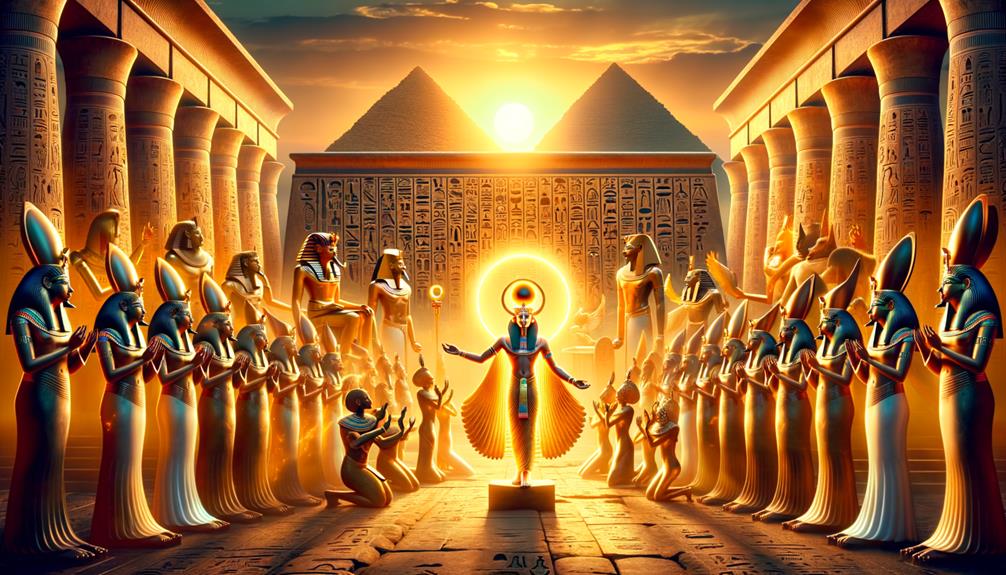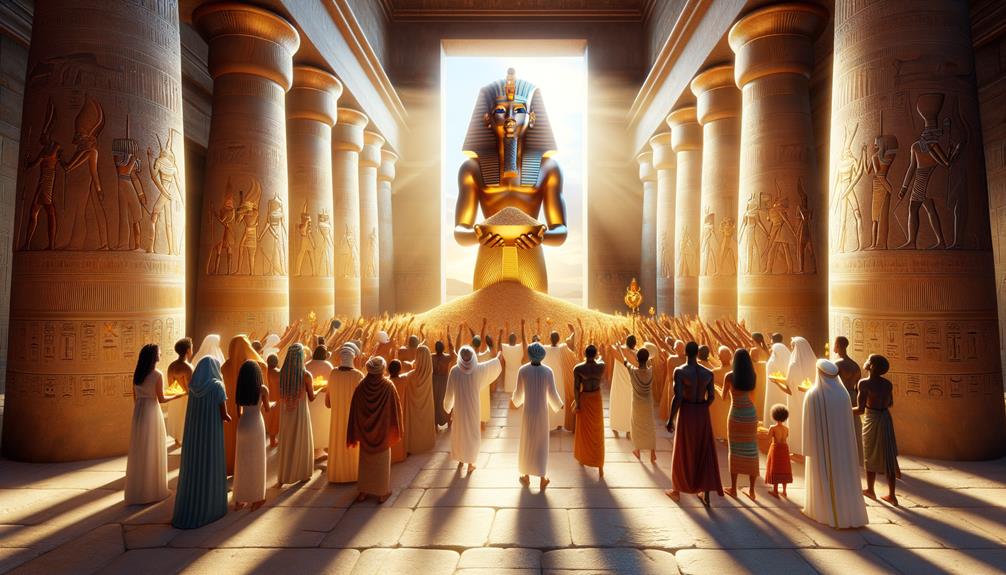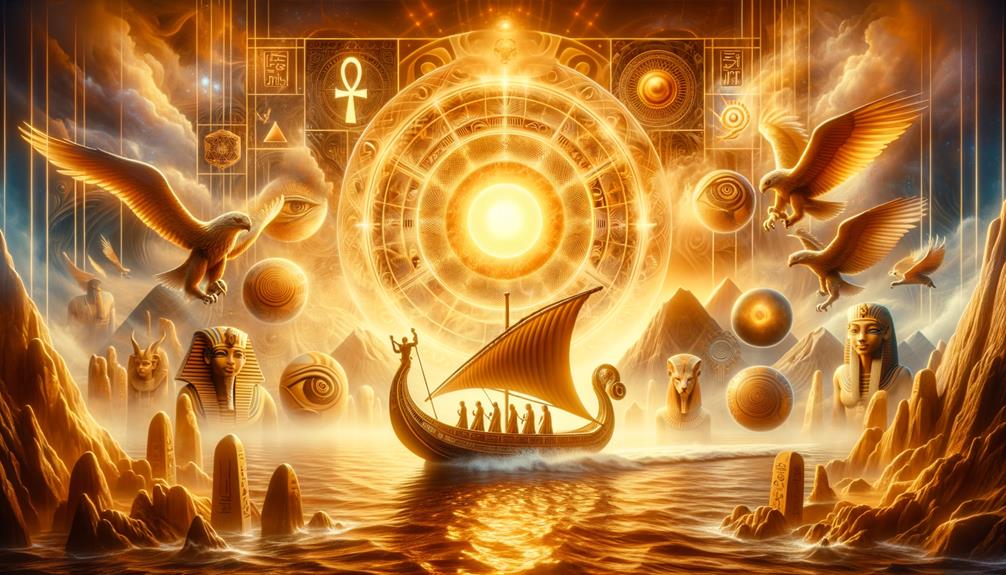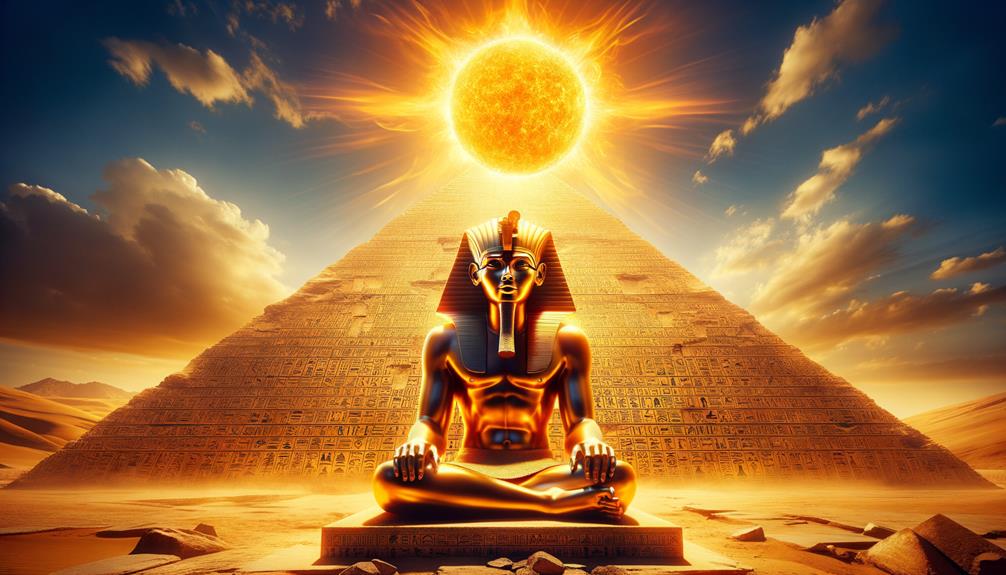So, there I was, standing under the blazing Egyptian sun, a symbol that's been linked for ages with Ra, the Sun God of Ancient Egypt. I found myself irresistibly pulled into the complex maze of myths, symbols, and history that surrounds this mysterious god. But, Ra was more than just the sun god. He symbolized order, creation, and even the essence of royalty. As a researcher, what captivates me isn't just interpreting the vivid symbolism related to Ra, but also unraveling why his influence persisted across various epochs of Egyptian history. Delving into Ra's story isn't just about academic interest; it offers a chance to understand a civilization's faith at its core and provides an intriguing peek into how the Ancient Egyptians saw their world and their role in it. So, are you up for joining me on this fascinating journey?
Understanding Ra's Divine Role

Let's have a chat about Ra, the sun god of ancient Egypt. But he's not just a sun god, he was an integral part of ancient Egyptian daily life. Think of him as the CEO of order, kings, and the sky, maintaining balance in the universe by battling the serpent of chaos, Apophis, every day. Ra was the boss of the gods, and his influence was everywhere. Basically, the ancient Egyptian universe revolved around him.
Now, being a sun god, Ra had a lot on his plate. Besides lighting up the world, he was responsible for carrying the sun across the sky in his solar barque. And let me tell you, it was no easy task, as it involved fighting Apophis, the embodiment of chaos. Ra was also a creator, believed to have given birth to the universe and life itself. His three daughters, known as the Eyes of Ra, were respected as symbols of his life-giving power.
One interesting thing about Ra is that his identity was kind of fluid. He often merged with other gods like Amun, Horakhty, Khepri, and Khnum, creating a complex network of divine beings. These combinations highlight the complexity and dynamism of ancient Egyptian faith, showing us that Ra wasn't a static figure but a deity with many facets, reflecting the diverse fabric of ancient Egyptian cosmology.
Decoding Ra's Iconography

When we focus on the imagery related to Ra, we uncover a wealth of symbols that give us a better understanding of his divine status and power. Known as the King of the Gods, the symbols associated with him mirror the power of a sunrise, his role as a sun god, and his position as the head honcho of the Egyptian pantheon.
Let's look at some key elements related to Ra's imagery:
- Ra is often shown as a man with a falcon's head, topped with a sun disk and a cobra. This represents his solar power and divine protection.
- The Eye of Ra, symbolizing his power and wrath, is a frequent feature in his imagery.
- Ra's connection with other Egyptian gods is also noteworthy. His persona is often intertwined with leading deities like Amun, Osiris, and Horus, underlining his dominant position within the Egyptian pantheon.
- The reverence for the Mnevis bull, seen as an embodiment of Ra's power, further highlighted his importance in Egyptian religious customs.
A closer look at Ra, the Sun God of Ancient Egypt, shows his pervasive and mighty status. Every symbol linked with Ra tells us something unique about his divine role and power.
Ra's Interactions With Other Deities

Let's take a look at Ra's deep-seated connections with other gods and goddesses, shall we? The tale of Ra, the Sun god of ancient Egypt, is full of intriguing interactions that highlight his importance and expose the detailed religious and cultural beliefs of the ancient Egyptians. Ra's influence wasn't limited to just the sun in the sky—it reached all the way into the underworld and beyond.
Case in point: Ra and Osiris, the underworld god. These two merged to symbolize the sun setting and the concept of death. Ra also joined forces with Amun, an ancient deity, creating Amun-Ra. This demonstrates Ra's ability to adapt and be everywhere at once.
Within the Ra cult, Ra's duties were pretty hefty. He was in charge of the sky, the earth, and the underworld. He didn't rule with kid gloves. Sometimes, he had to flex his muscles and order his daughter Sekhmet to discipline humanity. So, you can see that his relationships with other deities, including his own children, could be a bit complicated.
Ra's dealings with other deities, whether through family bonds, conflicts, or partnerships, make for a fascinating story. This deep dive into the complex and intricate world of ancient Egyptian mythology offers us a greater understanding of this ancient civilization.
Importance of Ra Worship

Delving into the heart of ancient Egyptian mythology, we find the pivotal role of the sun god, Ra. Ra's vast network of relationships with other deities paints a vivid picture of the complex and intricate belief system of this ancient civilization. But it's the passionate reverence for Ra that truly reveals the depth of his influence in their religious life.
Being one of the oldest deities, Ra's impact was far-reaching. His worship underscored the awe-inspiring power of the sun and his role as the life-bringer and the architect of the universe.
The significance of Ra's worship is seen in several ways:
- Tangible expressions of faith:
- The existence of temples devoted to Ra, particularly Sun Temples that bore considerable importance.
- The cult of Mnevis bull in Heliopolis, a prime location for worship.
- Its mythological implications:
- Ra's daily voyage across the sky, where he vanquishes Apophis, is seen as a symbol of light triumphing over darkness.
- The belief that Ra is the creator of the universe, a fundamental tenet in ancient Egyptian religion.
The worship of Ra was not simply about praising a deity; it was a reflection of their spiritual and cultural values. This made Ra, the Sun God of Ancient Egypt, an essential element of their religious existence.
Legends and Myths of Ra

When we delve into the rich stories surrounding Ra, we find a god who was more than just a symbol of the sun. He also represented order, royalty, and the essence of life. Ra, the sun god, was a central figure in Egyptian mythology. His daily journey across the sky was a symbolic representation of time and a daily battle against disorder, represented by the serpent Apophis.
In the stories of creation, Ra is said to have risen from the primeval waters, essentially birthing himself. As the god Atum, he is credited with the creation of the first divine pair, Shu and Tefnut, who subsequently gave birth to the earth and sky. For this reason, the ancient Egyptians viewed Ra as the progenitor of all things, including the Pharaohs, who were regarded as 'children of Ra'.
With the rise of Christianity, Ra's significance diminished, but his legacy persists in the Book of the Dead and other ancient writings. These texts provide a deep understanding of how the ancients viewed their world, their deities, and their position within the universe, highlighting the importance of Ra: the Sun God of Ancient Egypt, and his pivotal role in the stories and legends surrounding him.
Frequently Asked Questions
What Was Sun God Ra Known For?
You know, when we chat about ancient Egyptian culture, Ra is a name that often comes up. He's a pretty big deal, famed for his position as the sun god, the one who created the universe, and the guardian of order. Those epic trips he'd take across the sky are the stuff of legends.
What Is the Ancient Sun God Ra?
You might ask, "Who is Ra?" Well, let me tell you. Ra is quite a significant figure from ancient Egyptian times, widely admired as the sun god. His reputation stems from his daily trips across the sky and his legendary struggles with the demon Apophis. These tales beautifully illustrate the never-ending cycle of life.
What Is Ra the Sun God Secret Name?
You know, I've done some research on this fascinating topic. Turns out, according to the lore, Ra, the Sun God, had a secret name that held all his power. The story goes that Isis, in a clever scheme, managed to coax this name from him. However, here's the kicker – we don't actually know what this name was! Despite my best efforts, I couldn't find a single ancient text that records it. It's a bit of a mystery, isn't it?
Who Is Ra the Sun God Wife?
The sun god Ra from ancient Egypt was initially married to Hathor, a deity associated with music and motherhood. As time went on, Hathor's identity began to blend with other goddesses such as Sekhmet and Bastet. This represented a sense of balance and protection in the lineup of Egyptian gods and goddesses.

